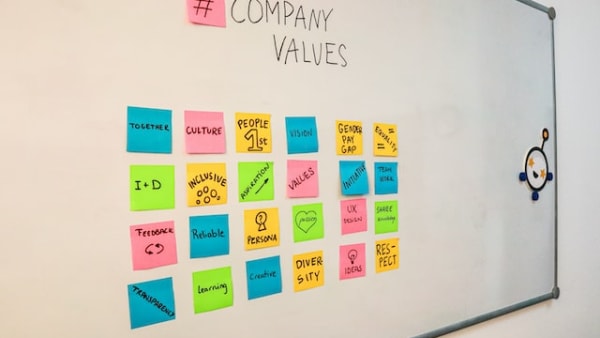
A Guide To The Cultural Web Model In HR
February 28, 2023

Organizational culture plays a critical role in driving business success. A positive culture can motivate employees, increase their job satisfaction and foster a sense of belonging, leading to higher retention and productivity.
By contrast, a negative culture can lead to high turnover rates, low morale and decreased productivity, which can ultimately harm a business's bottom line.
The Cultural Web model is a useful tool for understanding, analyzing and managing business culture. In this article, we explore the model in detail and provide a guide for HR professionals looking to implement it.
What is the Cultural Web model?
Developed in 1992 by Gerry Johnson and Kevan Scholes, the Cultural Web model sets out a paradigm of organizational culture. This paradigm suggests that culture is a complex and interrelated system of values, beliefs and practices that shape how work is done.
These values, beliefs and practices are explored through six elements:
Stories
Rituals and routines
Symbols
Organizational structure
Control systems
Power structures
By examining each of these elements, an organization can identify influencing factors that drive workplace behavior and decision making. This in turn helps it identify areas for improvement and develop strategies to enhance or change its culture as needed.
The 6 elements of the Cultural Web model
The six elements of the Cultural Web model are interconnected and interact with each other, shaping organizational culture in various ways. Recognizing the relationships between them is essential to successful application of the model.
Below we take a look at each element in detail.
1. Stories
Stories are narratives shared within a business, often passed down from one generation of employees to the next. They can take many forms, from informal anecdotes shared between colleagues to more formal company legends. They can be positive or negative, and can reflect an organization's history, successes, failures and challenges.
They serve as a way to share knowledge and experiences, reinforce cultural norms, and create a sense of belonging. By understanding the role of stories in the Cultural Web model, businesses can use storytelling to create a positive and productive work environment.
2. Rituals and routines
Rituals and routines are the daily activities, habits and practices that employees engage in as part of their work, whether through their own design or at the request of their employer.
These include things like regular meetings, performance management processes, team building exercises and away days - even a simple daily coffee break.
They provide a sense of structure and stability within a company and help to create a shared identity among the workforce. Understanding the rituals and routines that are present within an organization can provide valuable insight into cultural factors like collaboration, innovation and employee engagement.
3. Symbols
Symbols are the visual representations of an organization’s culture, and include things like logos, straplines, uniforms or dress codes, even the layout and design of office space.
Symbols are powerful because they provide a tangible representation of values and beliefs, and serve as a way to communicate them to employees, customers and other key stakeholders. Essentially, symbols are a company’s brand identity. They create a sense of unity and belonging among employees and help to establish a positive image for the business.
4. Organizational structure
Organizational structure refers to the internal structure of a business, including roles, responsibilities and reporting lines. It can affect how work is done, how decisions are made, and how information flows within the business, as well as influencing employee behavior and attitudes.
Leadership plays an important role here, since different leadership styles lead to different organizational structures.
For example, an autocratic leadership style where decisions are made by a single leader without input from others may result in a hierarchical organizational structure. This can lead to a culture where employees feel less empowered and less engaged in the decision making process.
5. Control systems
Control systems are the methods used by an organization to monitor, measure and manage performance. They include things like key performance indicators (KPIs), appraisals, incentives and rewards.
Control systems help to shape organizational culture by setting expectations, defining success and promoting accountability. For example, a control system that rewards individual performance could reinforce a culture of competition and individualism, while a system that rewards teamwork could reinforce a culture of collective effort.
Additionally, control systems can provide valuable feedback to employees, promoting a culture of continuous improvement.
6. Power structures
The final element of the Cultural Web model, power structures are the formal and informal systems of authority within a business. They determine who has the power to make decisions and how those decisions are made.
These systems can have a significant impact on organizational culture, shaping the way employees interact with each other and the way they behave.
For example, an organization with a highly centralized power structure may have a culture that values obedience and conformity, with a strong emphasis on following rules and procedures. On the other hand, an organization with a more decentralized power structure may have a culture that values creativity and innovation, with a strong emphasis on individual autonomy and decision-making.
Why is the Cultural Web model important?
The Cultural Web model is important because it provides a comprehensive framework for understanding and analyzing organizational culture. This is essential for several reasons.
First, culture has a significant impact on employee behavior and engagement. A positive and supportive culture can increase employee satisfaction and productivity, while a negative or toxic culture can lead to high turnover rates, low morale and poor performance.
Second, culture also influences the way an organization interacts with its customers and stakeholders. A company with a strong and positive culture is more likely to build trust and loyalty, while a company with a negative or inconsistent culture may struggle to maintain a positive reputation.
Finally, culture plays a critical role in shaping an organization’s ability to adapt to changing circumstances and remain competitive. A culture that values innovation, creativity and continuous improvement is more likely to identify and pursue new opportunities, while a culture that is resistant to change may struggle to keep up with evolving trends and technologies.
By breaking down organizational culture into six distinct yet interrelated elements, the model allows HR teams to identify the underlying values, beliefs and behaviors that shape operations and performance.
Benefits of the Cultural Web model
The Cultural Web model offers several benefits compared to other similar models for understanding organizational culture:
A holistic view: the Cultural Web model emphasizes the interdependence of cultural elements and how they work together to shape an organization’s culture. This provides a more holistic view than other models that treat cultural elements as discrete and independent factors.
A focus on change: the Cultural Web model is designed to help organizations identify areas where culture change is needed and develop strategies for implementing those changes. This focus on change is particularly valuable in today’s rapidly changing business environment, where organizations must adapt quickly.
Flexibility: the Cultural Web model is flexible enough to be applied to a wide range of organizations, from small start-ups to large multinational corporations. It can also be adapted to different industries, sectors and cultural contexts, making it a versatile tool.
Challenges of the Cultural Web model
While the Cultural Web model offers many benefits, it also has some challenges that HR teams may encounter when using it:
Complexity: whilst the interrelated elements of the Cultural Web model offer a holistic view, they can be difficult to isolate and analyze separately. HR teams may struggle to understand how each element of the model affects the others and how changes in one element can impact the overall culture.
Limited scope: the Cultural Web model primarily focuses on the internal aspects of an organization’s culture. It does not take into account external factors such as the impact of industry trends, regulatory environments and global economic conditions. This can limit its usefulness in certain contexts.
Time consuming: conducting a comprehensive analysis using the Cultural Web model can be time consuming and require significant resources. It may also require input from a wide range of stakeholders across the organization, which can be a challenge to coordinate.
Subjectivity: the Cultural Web model relies heavily on subjective interpretation and analysis, which can lead to biases and inaccuracies. Different stakeholders may have different perceptions of the organization’s culture, and reconciling these perspectives can be challenging.
Overall, while the Cultural Web model can be a useful tool for understanding and analyzing organizational culture, HR teams should be aware of these challenges and take steps to address them to ensure a successful application.
How can you use the Cultural Web model?
HR Teams can use the Cultural Web model to understand, manage and develop organizational culture. Here are the key steps to take:
Analyze your organization's current culture: the first step is to identify the existing cultural elements in your organization. This includes the stories, rituals and routines, symbols, organizational structure, control systems, and power structures that are currently in place.
Determine what changes need to be made: based on your analysis, you can identify areas where the current culture may be hindering business success or where changes could improve performance or morale. For example, you may identify a need to implement new control systems or change the organizational structure to better align with company goals.
Develop a plan to address the changes: once you have identified the areas for improvement, you can create a plan to address them. This might involve developing new policies, procedures, or training programs, or it could involve introducing new symbols or rituals to reinforce the desired culture.
Monitor progress and make adjustments: finally, it's important to monitor the results of your cultural changes and make adjustments as needed. This might involve soliciting feedback from employees, measuring key performance indicators, or adjusting your plan based on new information or unexpected challenges.
In summary, by using the Cultural Web model as a tool for understanding and managing organizational culture, HR teams can develop and enhance that culture in a way that supports strategic goals and helps to drive business success.
Boost your hiring power.
Start using Neuroworx today.
Talk is cheap. We offer a 14-day free trial so you can see our platform for yourselves.
Try for free




